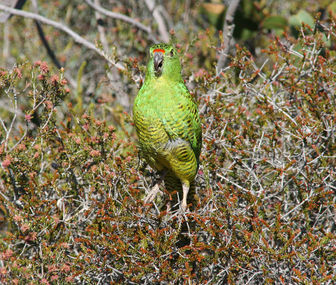Ground parrot
The coloration of the two Pezoporus species and the Kakapo is similar – yellowish-green with darker barring, somewhat reminiscent of the head and back of the wild-type budgerigar. This is not an indication of a true relationship, however, but either adaptation to a particular lifestyle or a feature retained from ancestral parrots; probably the latter as barred plumage is found all over the family, from the tiny tiger parrots to female cockatiels.

Original source: Brent Barrett from Dunedin, New ZealandPermission(Reusing this file)yes
Author: Brent Barrett from Dunedin, New ZealandPermission(Reusing this file)yes
The Ground parrot is classified as Least Concern. Does not qualify for a more at risk category. Widespread and abundant taxa are included in this category.
Eastern Ground Parrot is a secretive bright green ground dwelling parrot which is seldom seen. It inhabits dense heathlands in or near coastal regions of eastern and south-eastern Australia. It is one of three sub species occurring in Australia the others being, Pezoporus wallicus leachi in Tasmania and Pezoporus wallicus flaviventris in Western Australia. Photo: courtesy Graeme Chapman graemechapman.com. More
Ground Parrot at nest with chicks. Ground Parrot at nest with chicks. Photo: Norman Chaffer Estate © Australian Museum Ground Parrot chicks. Ground Parrot chicks. Photo: Norman Chaffer Estate © Australian Museum Distribution map of Pezoporus wallicus Distribution map of Pezoporus wallicus Map © Birds Australia Birdata Did you know? Ground Parrots prefer to run rather than fly away. They fly short distances and then run through the dense undergrowth. More
The Ground Parrot (Pezoporus wallicus) is one of only four ground-dwelling parrots in the world, the others being its closest relative, the extremely rare Night Parrot (Pezoporus occidentalis), the somewhat closely related Antipodes Island Parakeet (Cyanoramphus unicolor), and the unrelated highly endangered Kakapo (Strigops habroptila) from New Zealand. More
The Friends of the Western Ground Parrot are determined to save this species from extinction, but we cannot do it on our own. We need your help! Find out more about this very special bird and what you can do to help. Time is running out, so please don't wait until it is too late. Get involved now and help this beautiful bird. More
The Ground Parrot or Ground Parakeet (Pezoporus wallicus wallicus) is also known as the Eastern Ground Parrot, Swamp Parrot or Button-grass Parrot and is an Australian endemic and can be found along the eastern and southern coasts of Australia as well as interior Tasmania. More
Western Ground Parrots eat the seeds of various grasses, especially button grass (Mesomelaena sphaerocephala). Ground Parrots usually feed on the ground, eating seeds of sedges, grasses, herbaceous plants and shrubs. Although the Ground Parrot is an opportunistic feeder the bulk of its diet probably comprises species from the Restionaceae family. Western Ground ParrotCalls / Vocalization: This species is mostly quiet and silent in flight. More
Aspects of the topic ground parrot are discussed in the following places at Britannica. Assorted References * description (in parrot (bird)) ...one was found in 1990. It feeds at night on spinifex grass seeds and dozes under a tussock by day. Its nest is a twig platform in a bush and is entered by way of a tunnel. More
The beautifully patterned Ground Parrot is a medium-size bird (290-320mm), bright green with black and yellow markings and a pale yellow wing bar. It has a small orange-red band on the lower forehead. Habitat The Ground Parrot is a secretive bird found in the west of Tasmania, where it prefers buttongrass and open heathlands. The species is not usually seen unless it is flushed out from cover. More
Western Ground Parrot in shrubs © Brent Barrett Western Ground Parrot in shrubs © Brent Barrett Western Ground Parrot © Brent Barrett Western Ground Parrot © Brent Barrett Close up of a Western Ground Parrot (Pezoporus wallicus flaviventris) © Allan Burbidge More
Australia the Ground Parrot has been recorded from Fitzgerald River National Park and Cape Arid National Park. CURRENT POPULATION The total species population is not known; the nominate subspecies is believed secure but the western subspecies, numbering fewer than 450 birds divided between two populations in south-west Western Australia, is highly threatened. SIZE About 30cm, including a 20cm tail. WEIGHT Not available. AVERAGE LIFE EXPECTANCY Not available. NORMAL DIET Seeds and green shoots. More
The Western Ground Parrot is a medium-sized parrot with mainly green and yellow feathers which have brown and black flecks giving it an excellent camouflage. It has a bright red band above the beak. Its tail is quite long. wgp photo Adult Western Ground Parrot Immature birds are duller in colour and lack the red band above the bill. More
* Ground Parrot in Sydney * Where did it come from? * Sydney's resident ground parrot population? * Field surveys * What happened to the rescued bird? * Ground parrots in 2008? * A call heard in 2009 A Brief History of Sydney's Parrots = Although Sydney is a haven for many parrots today - More
The ground parrot is a distinctive, shy and elusive parrot endemic to Australia, with barred and mottled green plumage. They are found mostly in heath and sedgeland. They tend to stay in their own chosen territory, but will move away during fires. They live and nest - like their name suggests - on the ground, and when disturbed, prefer to run away, though they can fly for short distances; more sustained flights tend to be erratic in nature. More
The Tasmanian Ground Parrot is least endangered, and is most common in south west Tasmania The Eastern Ground Parrot occurs in fragmented populations near the coast in southern Queensland, New South Wales and Victoria and is considered vulnerable on the schedules of the NSW Threatened Species Conservation Act. More
Ground Parrot Bird Rare Pezoporus wallicus flaviventris World Trust Chargement… Faire un don à cette organisation Veuillez sélectionner le montant du don. More
Family : Psittacidae
Genus : Pezoporus
Species : wallicus
Authority : Kerr, 1792

